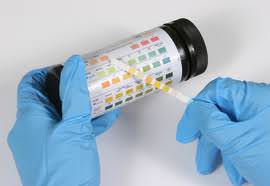You catch a cold. You decide that after trying to medicate yourself with an over the counter medications the symptoms are just not getting any better. So you head to the doctor’s office. You have your appointment with your physician and he then tells you he/she will need you to do a urinalysis, obtain a sample of your urine.
Soon after hearing this, you are handed a clear container and are directed towards the bathroom. After this your sample is taken to the laboratory to be analyzed.
But what exactly is being looked at in an urinalysis? How will your urine tell the doctor whats wrong?
This will ease the confusion and mystery of the importance of that little cup.
What is an Urinalysis?
An urinalysis is the examination of the physical, chemical, and microscopic elements of urine.
This first means that the appearance of the urine is looked at. How the urine looks in the container such as if there are particles present that can be seen by the naked eye is important. Other things such as the color, and if it is cloudy or pale are all used to contribute to the results.
If the urine is seen under a microscope then things such as mucus, urine crystals, the cells themselves and other substances are examined to identify if any bacteria are present.
The last part of the urinalysis consists of a dipstick. The dipstick is lined with 10 different colored pads that contain chemicals that change color when the substance of interest is present. This step tells the most about the urine.
What results do the Urinalysis dipstick yield?
There are 10 components to the dipstick step; they are:
Leukocytes: These are white blood cells. When you get an infection the number of leukocytes increases greatly. So if these come up as positive in the urinalysis then an infection is present.
Nitrite: This shows if there is bacteria in the urine. This can be the result of a Urinary tract infection being present.
Urobilinogen: This will be present in the urinalysis if liver disease is possible. It is normal to have a little bit of this in the urine. If it is a greater amount, it can suggest poisoning, restricted liver function, excessive RBC breakdown. If it is a lower amount this could mean a problem with bile production or an obstruction in the bile passage.
Protein: Protein in the urine will indicate that your kidneys are possibly damaged. This means that the filtering that this organ does is not properly working. Protein in pregnant women urine can be preeclampsia.
pH: This shows the acidity of the urine. The normal range for urine should be between 4.6 and 7. If the number is higher than that then this could be a possible sign of kidney stones, UTIs, kidney disease or diseases that affect growth in children. If it is lower then it could be because of uncontrolled diabetes, emphysema, dehydration, starvation, or severe diarrhea.
Blood/Hemoglobin: Blood in the urine is never good. This can indicate damage, inflammation, or a tumor of the kidneys. UTI infections, bladder cancer, or a blood disorder like sickle cell also can be suggested.
Specific Gravity: This is the concentration of the urine. It shows how well the kidneys balances the amount of water in the urine. The higher the concentration the more solid substances are present. The more water you drink the lower the specific gravity. Diuretics will have the same effect to create a lower gravity.
Ketones: Ketones in the urine can mean the person eats a low-carb diet, starvation, or an eating disorder. If a person fasts for longer than 18 hours they will be present as well. Also if a person is sick to the point where they can not eat or constantly vomits it shows. In a healthy pregnant woman, a low level may be found.
Bilirubin: This substance is found in bile which is a waste product of red blood cell breakdown; and is excreted by the liver. This is normally not found in the urine at all. Having this present shows the possibility of liver disease.
Glucose: Sugar in the blood is a sign of diabetes. Diabetes is when the body can not produce enough insulin in the body for functioning. Also can be an indicator of an adrenal gland problem, liver damage, or a brain injury. Having glucose in the urine while pregnant is normal.
Although this is not an in-depth look into the process and examination of an urinalysis, it does help with basic terminology of the main components of this lab test.
